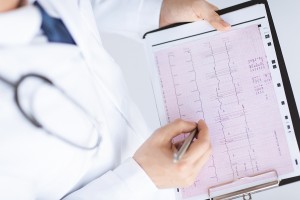 Echocardiograms are painless diagnostic procedures which use high frequency sound waves (ultrasound) to take moving pictures of the heart. It is possible to measure the size of the various chambers and to study the appearance and motions of the heart valves.
Echocardiograms are painless diagnostic procedures which use high frequency sound waves (ultrasound) to take moving pictures of the heart. It is possible to measure the size of the various chambers and to study the appearance and motions of the heart valves.
The echocardiography technician directs sound waves towards the heart from a small hand-held device. Objects, such as the heart walls and valves, reflect part of the sound waves back to the transducer. These reflections produce pictures of the heart on a television-like screen, which are recorded to DVD.
Measurements taken from these pictures are helpful in determining how well your heart is working. Your cardiologist can see whether or not there are any abnormalities present. Echocardiography can be used by your cardiologist to determine if there are any heart defects, valve abnormalities or abnormalities of the pumping chambers.
Preparing for the Procedure – What do you need to do?
You may eat and go about your normal activities unless otherwise informed. You will need to wear comfortable clothing. You should dress in an outfit which allows you to undress to the waist. You will be required to remove your top, but you will be given a surgical gown to wear throughout the procedure.
Echocardiography What happens?
The echocardiographic examination is performed and recorded by a highly trained Echocardiographer. Your cardiologist will read the results.
It may take up to an hour for the examination. A ‘transducer’ will be placed directly on the chest wall or upper abdomen for the examination. You will be offered a gown or a sheet to keep you warm. This also minimizes the area on the chest that must be exposed at any one time for the comfort of the patient.
During the test, small adhesive patches are used to attach small wires to the chest. To improve the quality of the picture, an odourless and water-soluble “gel” is applied to the skin where the transducer will be placed. This may feel cool and a bit moist, but the “gel” is easily removed at the end of the examination. Occasionally, more than one transducer may be applied to the chest and also heart sounds or pulses may be recorded along with the echocardiogram.
Patients are asked to lie on an examination table. To allow for better pictures, patents are frequently asked to change position from lying flat to lying on the left side during the test. Patients may also be asked to hold their breath for intervals during the procedure.
Possible Complications And Risk
There are no known harmful or proven adverse effects from cardiac ultrasound.
During the procedure it is normal to feel a slight pressure and/or vibration from the transducer, but this is not painful. During the examination the room lights may be dimmed to allow the technician to better see the screen.
When Will I Know What the Results of the Test Are?
Although the Echocardiographer performing this test may explain what is being seen on the screen, it is essential to obtain precise measurements from the paper and video recordings. Your cardiologist will confer with you in regards to the findings of these measurements.
If you have had previous echocardiograms, your cardiologist will compare the new ones with older ones, cross-referencing with other data. These results will be typed out and sent to your referring Practitioner and your cardiologist will ask you to return for a short revisit to the rooms to discuss the findings and future care options.

